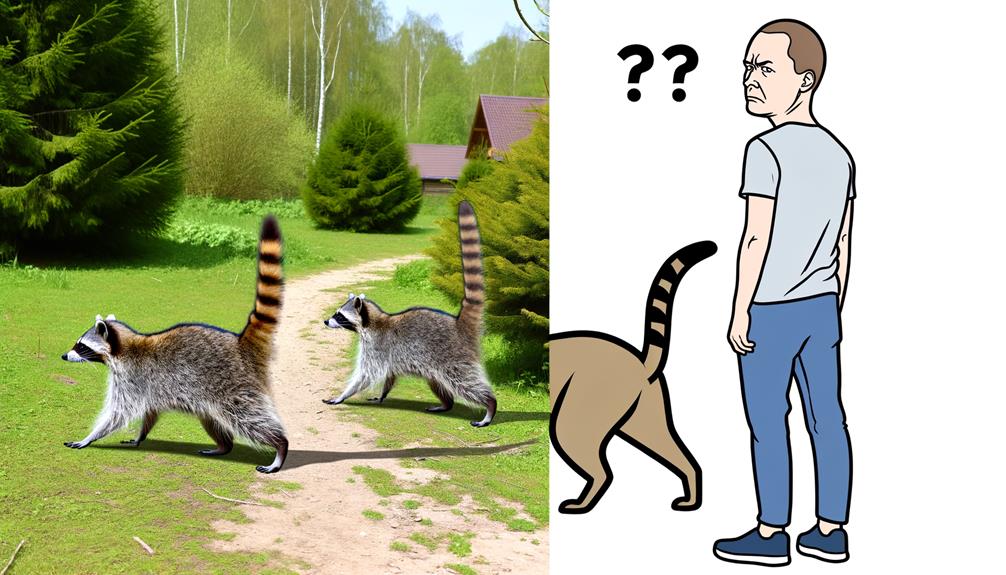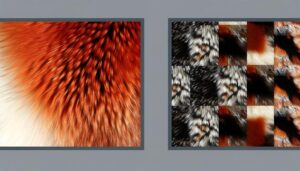Do Raccoons Spray Like Cats to Mark Territory?
Raccoons, or Procyon lotor, differ from cats in their communication methods and sensory behaviors. While Felis catus use spraying as a territorial or courtship behavior, raccoons employ other strategies such as leaving droppings, tracks, feeding remnants, or secreting scents from glands.
Spraying, as seen in felines, is not a part of a raccoon's communication repertoire. Unpleasant odors related to raccoons often stem from their urine or foraging habits, not deliberate spraying.
Clear apprehension of this nocturnal creature's intricate behavioral tendencies and habits can enhance our understanding of its interactions with the surrounding environment.

Key Takeaways
- Raccoons do not spray like cats, as they lack spray glands.
- Raccoons communicate through vocal sounds, body language, and scent marking.
- The primary sources of strong odors from raccoons are droppings or food, not spraying.
- Raccoons mark their territory through scrubbing, droppings, scratches, feeding remnants, and scents.
- Unlike cats, raccoons use latrines for consistent defecation as a form of scent marking.
Understanding Raccoon Behavior
Exhibiting a wide range of behaviors due to their adaptability and intelligence, raccoons display unique characteristics that set them apart from other mammals. A thorough understanding of which is essential in determining whether or not they possess the ability to spray like cats.
Raccoons are known to be dexterous, nocturnal, and omnivorous creatures with a penchant for exploration. Their distinct behaviors, such as washing food and their ability to open complex locks, exhibit their cognitive prowess.
However, unlike many mammals, their scent marking behaviors are not fully understood. Scientific research has yet to definitively determine if raccoons use scent as a form of territorial marking in the same way cats do.
Future investigations will surely shed light on this intriguing aspect of raccoon behavior.
Raccoons Vs Cats: a Comparison
Drawing a comparison between raccoons and cats, particularly regarding their scent-marking behaviors, requires a thorough understanding of the unique traits and characteristics each species possess.
Raccoons, Procyon lotor, are intelligent omnivores that utilize their well-developed sense of touch and manual dexterity. In contrast, cats, Felis catus, are obligate carnivores with a keen sense of smell and sight.
Raccoons communicate through a variety of vocalizations, body language, and scent-marking. Cats, however, mainly rely on visual and olfactory signals, including spraying, for communication.
While both animals utilize scent marking, their motivations and methods vary significantly, with raccoons primarily using it for territorial purposes, and cats for both territorial and sexual communication. This stark contrast underlines the importance of species-specific behavioral understanding.
The Truth About Raccoon Spraying
Moving further into our exploration of raccoon behaviors, it becomes imperative to address and demystify the act of spraying, a phenomenon often inaccurately attributed to these adaptable creatures. Contrary to popular belief, raccoons do not engage in spraying as a form of territorial marking or communication as seen in cats.
Here are some key points to bear in mind:
- Raccoons are not physiologically equipped to spray like felines.
- Raccoons communicate through a combination of body language, vocal sounds, and scent marking, but not by spraying urine.
- Any foul smell associated with raccoons typically originates from their droppings or the food they eat.
- Raccoon urine, like that of many animals, may have a strong odor, but it is not used in a spraying context.
- Raccoons are more likely to leave behind physical signs of their presence, such as tracks or tipped over garbage cans.
What Attracts Raccoons?
To comprehend the behavior and habits of raccoons, it is essential to understand the elements that draw them to particular environments.
Primarily, two factors play significant roles: accessible food sources and safe habitats.
An analysis of these factors will shed light on the ecological and behavioral dynamics influencing raccoon presence and activities in various settings.
Raccoon Temptations: Food Sources
Attracted by a myriad of food sources, raccoons are often lured into human settlements, displaying a particular fondness for trash bins, pet food, and gardens rich in fruits or vegetables. Their omnivorous diet and adaptable nature make them opportunistic feeders, exploiting food sources that are readily available.
Here are five common food temptations that attract raccoons:
- Trash bins: Raccoons are known for rummaging through garbage, attempting to find leftover food.
- Pet food: If left outdoors, pet food can become an easy target for hungry raccoons.
- Gardens: Fruits, vegetables, and plants are all appealing to raccoons.
- Bird feeders: The seeds and nuts often found in bird feeders make them a popular target.
- Compost piles: These can provide an abundant source of food if not properly sealed.
Understanding these attractions can help in minimizing human-raccoon interactions.
Raccoon Attraction: Safe Habitats
In addition to food sources, a significant factor that draws raccoons to human settlements is the availability of safe and comfortable habitats. These adaptable creatures are attracted to areas that provide ample cover and protection from predators, such as wooded areas, attics, chimneys, or beneath decks. They also seek out locations with easy access to water.
Scientific analysis of raccoon behavior shows that they prioritize habitats that offer a balance between safety and access to resources. They demonstrate an uncanny ability to exploit human-made structures, transforming these into ideal sanctuaries. As a result, meticulous management of our living spaces is vital to discourage raccoon habitation, thereby preserving our freedom from unwanted wildlife interactions.
How Raccoons Mark Their Territory
Examining the unique methods raccoons employ for marking their territory reveals a fascinating blend of behaviors, which, contrary to popular belief, do not include spraying like cats. These intelligent creatures use alternative strategies to establish their dominion, ranging from physical changes to their environment to using distinct scents.
- Scrubbing: Raccoons often scrub areas to deposit their scent.
- Droppings: They use latrines, places where they consistently defecate, as scent-markers.
- Scratches: Raccoons scratch trees or structures, leaving visible signs of their presence.
- Feeding Remnants: Leftover food can serve as an indirect marker of territory.
- Scents: Although not through spraying, raccoons secrete scents from their glands to mark their domain.
Understanding these tactics enriches our knowledge of these nocturnal creatures, paving the way for harmonious coexistence.
Raccoons and Domestic Pets: Coexistence
The coexistence of raccoons and domestic pets presents a unique set of challenges and interactions. An analysis of these interactions is essential to understand the behavioral dynamics involved and the potential risks posed to pets by raccoons.
In addition, effective management strategies need to be examined in order to mitigate any potential conflicts and promote a peaceful cohabitation.
Raccoons' Interaction With Pets
Despite their seemingly playful demeanor, raccoons can pose significant risks to domestic pets due to their unpredictable behavior and potential to carry diseases.
- Raccoons are known to be carriers of rabies, a deadly disease that can be transmitted to pets through bites or scratches.
- Their sharp claws and teeth can inflict serious injuries during encounters with pets.
- Raccoons are nocturnal creatures and their activities might disrupt the sleep patterns of domestic pets.
- The curious nature of raccoons may lead to destructive behavior, damaging property, and potentially causing harm to pets.
- Raccoons are notorious for their raiding tactics, often targeting pet food sources and creating competition for resources.
Understanding these interactions is crucial in ensuring the safety and health of household pets while maintaining the freedom of wild raccoons.
Managing Raccoons and Pets
Coexistence between raccoons and domestic pets requires a balanced approach that considers the natural behaviors and potential risks associated with these wild creatures, while also prioritizing the health and safety of pets.
As nocturnal, opportunistic feeders, raccoons pose a significant threat to pets due to potential transmission of diseases like rabies and parasites.
Mitigation strategies should involve proper waste management to deter raccoons from approaching residential environments. In addition, pets should be vaccinated regularly against common raccoon-borne diseases.
Encouragingly, with proper management, it's possible to minimize the interaction between raccoons and pets, thereby promoting a harmonious coexistence.
This balance of freedom for both species is essential for maintaining ecological balance while ensuring pet safety.
Preventing Raccoon Intrusion
In order to effectively prevent raccoon intrusion, it is important to understand their behavioral patterns, habitat preferences, and the attractants that lure them into human dwellings.
- Raccoons are nocturnal, so they usually invade homes at night.
- They have a keen sense of smell and are attracted to food sources, including garbage bins and pet food.
Raccoons prefer habitats with easy access to water and shelter, which often includes urban and suburban areas.
- They are skilled climbers and can gain access to rooftops, chimneys, and other high places.
- Raccoons are persistent, and if they find a potential food source or shelter, they will try to access it repeatedly.
Addressing these factors meticulously will help maintain your desired freedom from raccoon invasions.
Common Myths About Raccoons
What misconceptions, often perpetuated by folklore and popular culture, surround the behavior and characteristics of raccoons? To address this, let's debunk some common myths using a scientific and analytical approach that values the freedom of knowledge.
| Myth | Misconception | Fact |
|---|---|---|
| Raccoons Wash Their Food | They're believed to wash their food, mimicking human behavior. | Actually, 'dousing' behavior is not about cleanliness, but is a way to gather information about their food. |
| Raccoons are Nocturnal | They're seen only at night, hence they're considered nocturnal. | Raccoons are more 'nocturnal' in urban areas. In rural areas, they can be active during the day. |
| Raccoons are Vermin | They're often labeled as vermin due to their scavenging habits. | Raccoons are intelligent, adaptable mammals that play a role in ecosystem health. |
| Raccoons Spray Like Cats | Many people believe that raccoons spray like cats when threatened. | Raccoons don't have spray glands and cannot spray like cats. |
The Impact of Raccoons on Your Property
Evaluating the substantial impacts of raccoon presence on private properties reveals an array of potential concerns, including the risk of structural damage and the likelihood of disease transmission. The implications of these nocturnal creatures' activities are far-reaching, affecting not only the physical condition of properties but also the health and well-being of residents.
Here are some key impacts to take into account:
- Structural damage: Raccoons can cause significant harm to roofs, walls, and insulation.
- Disease transmission: Raccoons can carry rabies, leptospirosis, and other zoonotic diseases.
- Trash dispersal: Raccoons are notorious for rummaging through garbage, resulting in messes.
- Garden destruction: They can devastate vegetable gardens and fruit trees.
- Noise pollution: Their activity, especially at night, can disrupt sleep and cause distress.
Understanding these effects can inform effective raccoon management strategies, preserving freedom and peace in your home.
Conclusion
To sum up, while raccoons do not spray like cats, they are known to mark their territories through other means such as urine and feces. This behavior, akin to a graffiti artist marking their territory, can lead to significant damage and potential health risks for homeowners.
Hence, comprehending and managing raccoon behavior is essential to uphold a safe and clean environment. As highly adaptable creatures, suitable preventive measures are required to deter these animals from residential areas.






